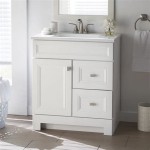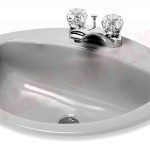What is a Sink in the Bathroom Called?
The fixture commonly known as a sink in a bathroom is technically referred to by several names, encompassing both broader categories and more precise classifications based on its design and function. While "sink" is a universally understood term, plumbing professionals, designers, and manufacturers often employ more specific terminology to accurately describe the type of basin present. Understanding these various terms allows for clearer communication and informed decision-making when renovating a bathroom, purchasing fixtures, or discussing plumbing needs with specialists.
The most encompassing term, applicable to most bathroom sinks, is simply a “basin.” A basin refers to any open container, typically bowl-shaped, designed to hold water for washing or other purposes. This is a broad term that applies not only to bathroom sinks but also to kitchen sinks, laundry sinks, and even large containers used for industrial purposes or agriculture. In the context of a bathroom, a basin specifically refers to the fixture where individuals wash their hands, face, or brush their teeth. The term highlights the fundamental function of the fixture: a receptacle for water.
Another common term, particularly within the plumbing and construction industries, is "lavatory." This term is considered more formal and precise than "sink." A lavatory, by definition, is a fixture specifically designed for washing hands and face. It's typically connected to a water supply (both hot and cold) and a drainage system. While the term "lavatory" can technically refer to a complete bathroom (including the toilet), in most contexts, it specifically designates the sink or washbasin. Using the term "lavatory" conveys a level of technical accuracy, differentiating it from more general terms like "sink" or "basin." This term is often found in building codes, plumbing specifications, and architectural drawings.
Beyond these general terms, bathroom sinks are often categorized by their mounting style. This classification is crucial when discussing installation and design options, as each mounting style has distinct aesthetic and practical implications.
Types Based on Mounting Style
Several distinct mounting styles exist for bathroom sinks, each offering a unique aesthetic and functional profile. Understanding these variations is crucial for both homeowners and professionals when planning or executing a bathroom renovation project. Each style impacts the space available, the ease of cleaning, and the overall design aesthetic of the bathroom.
One of the most common types is the
pedestal sink
. A pedestal sink consists of a basin mounted on a freestanding pedestal base. The pedestal provides support for the basin and conceals the plumbing. Pedestal sinks are often chosen for their classic and space-saving design, particularly in smaller bathrooms where maximizing floor space is a priority. They offer a clean, minimalist look, but generally lack integrated storage. The plumbing is often partially visible from the back unless a shroud or additional covering is used.Another prevalent type is the
undermount sink
. An undermount sink is installed beneath the countertop, with the rim of the sink attached to the underside of the counter. This style provides a seamless, clean look, as there is no visible lip or edge of the sink above the counter surface. Undermount sinks make countertop cleaning easier, as crumbs and spills can be wiped directly into the sink without obstruction. This type of sink requires a solid surface countertop material, such as granite, quartz, or marble, due to the way it is mounted and the need for a water-resistant, durable surface around the sink opening.Vessel sinks
, also known as above-counter sinks, are designed to sit on top of the bathroom countertop, resembling a decorative bowl. They come in various shapes, sizes, and materials, offering a wide range of aesthetic possibilities. Vessel sinks add a unique focal point to the bathroom and can be paired with different faucet styles, including wall-mounted or extended-height faucets. Installation typically requires careful consideration of the countertop height and faucet reach to ensure comfortable use.A
wall-mounted sink
is attached directly to the wall, without the support of a pedestal or cabinet. Wall-mounted sinks are advantageous in small bathrooms as they maximize floor space and create an open, airy feel. They offer adjustable height options, making them accessible for individuals with mobility issues. However, the plumbing is often exposed, requiring the use of decorative traps and supplies or a partial shroud for aesthetic appeal. Proper wall reinforcement is essential to ensure the sink is securely mounted and can support the weight of the basin and water.Console sinks
combine elements of pedestal and wall-mounted sinks. They consist of a basin supported by legs or a frame, often made of metal. Console sinks provide a more substantial look than wall-mounted sinks while still offering some visual openness and under-sink space. Some console sinks include a shelf or small storage area beneath the basin. They are a popular choice for bathrooms seeking a balance between traditional and modern design elements.Finally,
drop-in sinks
, also called self-rimming sinks, are installed into a pre-cut hole in the countertop. The rim of the sink rests on the countertop, providing support and covering the edge of the hole. Drop-in sinks are relatively easy to install and are compatible with various countertop materials. They are a common and versatile choice for bathrooms of all sizes and styles. The visible rim can sometimes trap dirt and debris, requiring regular cleaning.Materials and Construction
The materials used in the construction of a bathroom sink play a key role in its durability, aesthetic appeal, and ease of maintenance. Different materials offer distinct advantages in terms of resistance to staining, scratching, and chipping, as well as contributing to the overall design style of the bathroom. Understanding these material properties is crucial for selecting a sink that meets both functional and aesthetic needs.
Vitreous china
is one of the most common materials for bathroom sinks. It is a ceramic material that has been glazed and fired at high temperatures, resulting in a durable, non-porous surface. Vitreous china is resistant to stains, scratches, and acids, making it easy to clean and maintain. It is available in a wide range of colors and styles, offering versatility in design. The smooth, glossy finish of vitreous china contributes to a clean and hygienic appearance.
Porcelain
is another frequently used material, often used interchangeably with vitreous china. While both are ceramic materials, porcelain generally refers to a broader category, while vitreous china is a specific type of porcelain that has been treated to achieve a more glass-like, non-porous finish. Porcelain sinks are also durable and resistant to stains, making them a practical choice for bathroom applications.
Cast iron
sinks consist of a cast iron base coated with a layer of enamel. These sinks are exceptionally durable and resistant to chipping and scratching. The enamel coating provides a smooth, non-porous surface that is easy to clean. Cast iron sinks are often heavier and more expensive than other types of sinks, but their durability and classic aesthetic make them a popular choice, especially for those seeking a vintage or traditional look. They also retain heat well.Stainless steel
sinks are primarily used in kitchens and laundry rooms, but can also be found in modern bathroom designs. Stainless steel is a durable, corrosion-resistant material that is easy to clean. Stainless steel sinks are typically less expensive than other types of sinks and offer a sleek, contemporary look. However, they can be prone to scratches and water spots, requiring more frequent cleaning to maintain their appearance. Gauges and finishes vary widely, influencing price and durability.
Glass
sinks, often made from tempered glass, offer a unique and visually striking option for bathroom design. Glass sinks can be clear, frosted, or colored, providing a wide range of aesthetic possibilities. They are generally easy to clean but can be susceptible to scratches and chips if not handled carefully. The thickness and quality of the glass are crucial factors in determining the sink's durability. Special cleaning products are often recommended to maintain the clarity and shine of the glass.
Stone
sinks, made from materials such as granite, marble, or travertine, offer a luxurious and natural aesthetic. Stone sinks are durable and resistant to heat, but they can be porous and susceptible to staining if not properly sealed. Regular sealing is necessary to protect the stone from water damage and stains. Stone sinks are typically more expensive than other types of sinks, but their unique beauty and durability make them a desirable choice for high-end bathrooms. The veining and color variations in natural stone create a one-of-a-kind appearance.The Importance of Plumbing Considerations
Regardless of the term used to describe a bathroom sink – basin, lavatory, or a more specific designation based on mounting style and material – proper plumbing connections are critical for its functionality. Incorrect plumbing can lead to leaks, clogs, and other issues that compromise the usability of the fixture. Understanding the basic plumbing requirements for different sink types is essential for ensuring a successful installation and preventing future problems.
All bathroom sinks require both a water supply and a drainage system. The water supply typically consists of two pipes, one for hot water and one for cold water, connected to the faucet. The drainage system consists of a drainpipe connected to the sink's drain and leading to the main plumbing system. Proper connection of these elements is necessary to ensure water flows smoothly into the sink and wastewater efficiently exits the sink.
The drainpipe typically includes a P-trap, a curved section of pipe designed to trap water and prevent sewer gases from entering the bathroom. The P-trap also catches debris that may clog the drainpipe. Regular cleaning of the P-trap is recommended to prevent clogs and maintain proper drainage. The P-trap’s depth and configuration are dictated by local plumbing codes.
The faucet is a crucial component of the sink, controlling the flow of water and allowing users to adjust the temperature. Faucets come in various styles and configurations, including single-handle faucets, two-handle faucets, and touchless faucets. The choice of faucet should be based on personal preference, design aesthetic, and ease of use. The faucet's spout reach and height must be appropriate for the sink's size and shape to prevent splashing and ensure comfortable use.
Overflow drains are another important consideration. Many bathroom sinks include an overflow drain, a small opening near the top of the basin that prevents water from overflowing if the drain is clogged. The overflow drain is connected to the main drainpipe, providing an escape route for excess water. Regular cleaning of the overflow drain is recommended to prevent buildup of debris and ensure proper function. Not all sinks have overflow drains, especially some vessel sink designs.
Finally, compliance with local plumbing codes is essential for any bathroom sink installation. Plumbing codes vary by location and specify requirements for pipe size, materials, and installation techniques. Consulting with a licensed plumber is recommended to ensure that all plumbing connections are made in accordance with local codes and regulations. Failure to comply with plumbing codes can result in fines and require costly repairs.

What Is The Difference Between Sink And Wash Basin

Parts Of A Sink The Home Depot

Types Of Bathroom Sinks The Home Depot

Types Of Bathroom Sinks The Home Depot

Types Of Bathroom Sinks The Home Depot

Sink Wikipedia

Bathroom Sink 101

Types Of Bathroom Sinks The Home Depot
Bathroom Sink Material Guide Signature Hardware

How Many Bathroom Sink Options Are Too Rhode Kitchen Bath Design Build
Related Posts







